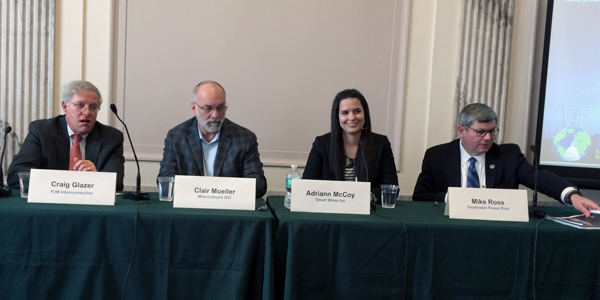By Wayne Barber
WASHINGTON — Choices made by customers on issues ranging from carbon dioxide to technology could rank alongside decisions made by policymakers in shaping the future of the grid, RTO officials said last week.

This was a recurring theme during a Feb. 16 briefing by WIRES, the House Grid Innovation Caucus, the National Electrical Manufacturers Association (NEMA) and the Environmental and Energy Study Institute (EESI). “Unlike ever before, the electric customers are actively participating in the industry,” said Adriann McCoy, a vice president of Smart Wires, which makes advanced power flow control technology. The growing clout of end users is reflected in rooftop solar, plug-in electric vehicles and consumers’ purchasing of renewable power from alternative suppliers, she said.
“Anytime consumers start playing more actively in a market,” it brings about innovation, McCoy said.
Coal plant retirements, such as the recently announced plans to close the Navajo power plant in Arizona, will require that electricity be moved from other sources, McCoy said. The utility owners of the Navajo plant said Feb. 13 that they don’t plan to operate the facility beyond December 2019.
Speakers said people’s choice about where their power is coming from is driving the transmission system. This includes decisions favoring renewable energy and less-carbon-emitting sources.
“The planning is only slightly less complicated than the engineering” these days, said former FERC Chairman Jim Hoecker, counsel to WIRES. “It’s a challenging time, it’s a transformative time, for the electricity business.”
At the same time, a robust transmission system will save consumers billions every year in avoided power disruptions, Hoecker said. “That’s not pocket change,” he added.

MISO Executive Vice President Clair Moeller said it is resilience and the need to move power from new low-carbon resources that is driving new transmission. “There is essentially no load growth in the nation,” he said. “My job at MISO is mostly about planning,” Moeller said. Sometimes “you get cheaper electricity from your next-door neighbor,” rather than from the generating unit in your own area, Moeller said.
Congress in 1992 said it wanted to see more electric competition, said Craig Glazer, PJM vice president for federal government policy. But even since the Energy Policy Act of 1992, lawmakers still engage in picking winners and losers, Glazer said.
The wind production tax credits and state bailouts of struggling nuclear plants can make things complicated, Glazer said. But Glazer cautioned against too much market tinkering, noting that the goal of competition was to shift risk from ratepayers to shareholders.

Innovation happens quickly, but “Congress doesn’t move very fast,” said former U.S. Rep. Mike Ross, senior vice president for government affairs at SPP. Congress needs to ensure its laws “don’t get in the way” of innovation, Ross said.
Many panelists said while the concept of regional planning is popular in the abstract, it often runs into roadblocks in the real world. For example, states are all over the board on issues like renewable mandates, Moeller said.
“States have not wanted to relinquish their regulatory authority over utility operations. This is a tremendous burden to interstate commerce,” Hoecker said.
“We want to make sure this [electric transmission issue] is front and center … that people know how important this is,” said Rep. Jerry McNerney (D-Calif.), who co-chairs the House Grid Innovation Caucus along with Rep. Bob Latta (R-Ohio).



